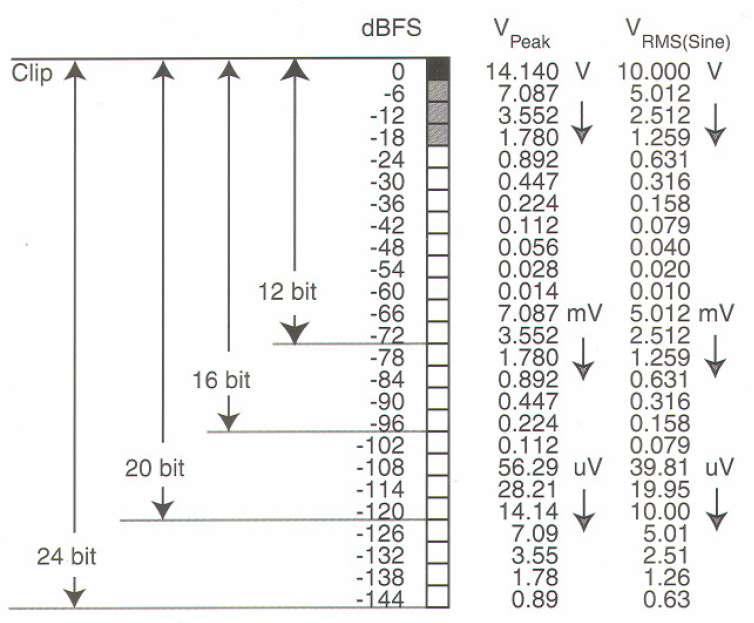[1] If it is at -30dBfs, and 16 bits are available, how many bits is it using? [1a] If it is at full scale - 0dBfs - (cover your ears!!), how many of those 16 is it using?
[2] Yes: Sampling rate is the horizontal axis, and bit depth is the vertical. The higher of either, preferably the higher of both, the more discrete points you have that are closer to 'real life' sounds, hence less quantization error.
1. Each bit represents about 6dB of dynamic range, hence 16bit x 6 = 96dB dynamic range and 24bit x 6 = 144dB dynamic range. Your test signal would use say 2bits, if it's at -30dBFS then that would be somewhere around bit 4 to bit 6, all the other bits would be empty (zero).
1a. It is still using about two bits, it will always use about two bits at any bit depth, the difference is that as it's now peaking at full scale, it will occupy bits 1-2, and all the other bits will be zero.
2. That's not how digital audio works. Digital audio data is NOT attempting to be closer to "real life", it is attempting to store co-ordinates which will allow "real life" to be reconstructed. This is how digital audio is different to analogue audio, because analogue audio IS trying to be closer to "real life". This is where digital audio can be difficult to understand, counter-intuitive in some respects, and why so many audiophiles get it wrong. They tend to think of digital audio as being the same as analogue audio but just using digital data instead of analogue information but this is not how digital audio works, it uses an entirely different approach. As you like analogies, maybe this one will help:
Let's say we have a perfect circle drawn on a piece of paper and we want to copy it and then print it out on another piece/s of paper. There are two approaches to doing this, we'll call them the analogue approach and the digital approach. With the analogue approach we try to copy that circle as closely as possible, we store all that information and then send it to our printer and printout a copy. The digital approach is entirely different; first of all we create a set of mathematical instructions inside our printer which causes it to only print perfect circles. Next we measure just two points on our original circle and store those two points. Finally, we send those two points to our printer, which prints out a perfect circle that bisects our two points, the end result being a perfect copy of the original. ... From this we can see two things: Firstly, with our analogue approach the information we store is a representation of "real life", it's analogous to our original circle and hence why we've called it the "analogue" approach. The information we store with the digital approach is completely different though, it's just two data points which don't look anything like our circle, they are not a representation of "real life" ("analogous" to our original circle), they just represent the co-ordinates of our original circle. Secondly, two data points (co-ordinates) are enough to ensure our printout is a perfect copy of our original, measuring and storing say 1,000 points/co-ordinates is not going to make our printed copy more accurate or better in any way.
Same with digital audio, we must have at least 2 sample points (co-ordinates), 100 or 10,000 sample points makes no difference. Hence why the sample rate is always double the highest audio frequency we can capture. With your test signal at 3kHz, you would need a sample rate of at least 6kHz. Using a sample rate of 96kHz would make no difference. It's a similar story with bit depth: Fewer bits means greater quantization error but there is a mathematical process which converts that error into white noise. So at any bit depth we always have an error free (perfect) signal! However, we also have some white noise accompanying our perfect signal and as our number of bits increase, so the amount of white noise decreases (each additional bit reduces the amount of white noise by 6dB). All we have to do is ensure the amount of white noise is below audibility, which typically occurs with about 12bits or so, giving us a safety margin of about 4 bits (24dB) with 16bit. More than that is irrelevant, 24bit does not give us any more accuracy than 16bit, both are error free (perfect) the only difference is that 24bit has a noise floor another 48dB lower.
The take away from all this is that as far as human hearing is concerned, High-Resolution digital audio results in an output which is exactly the same resolution as CD!
G





